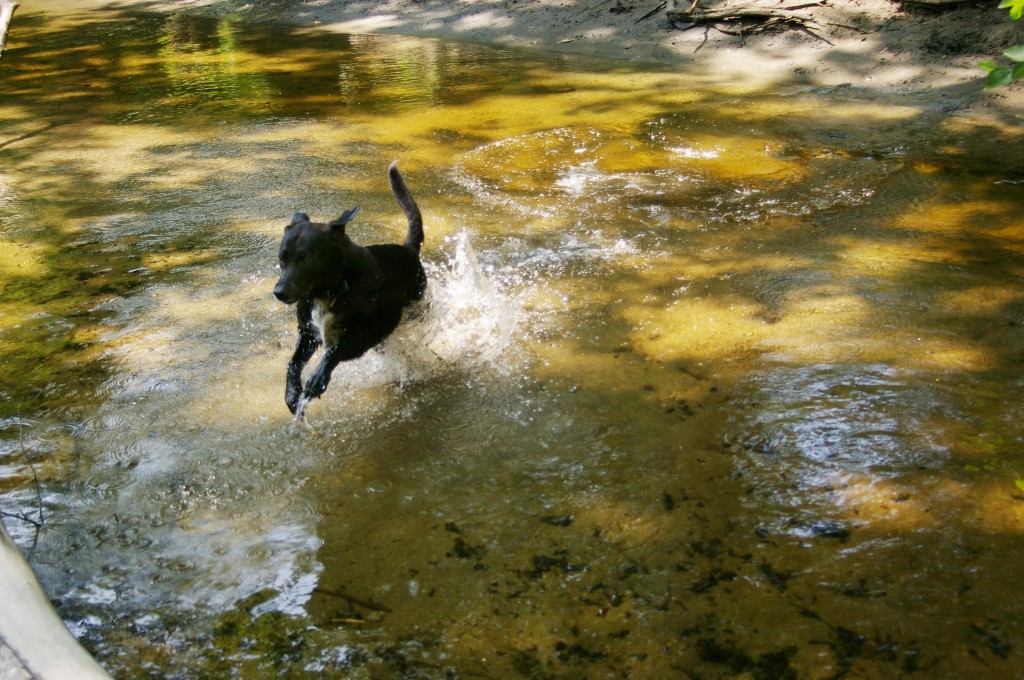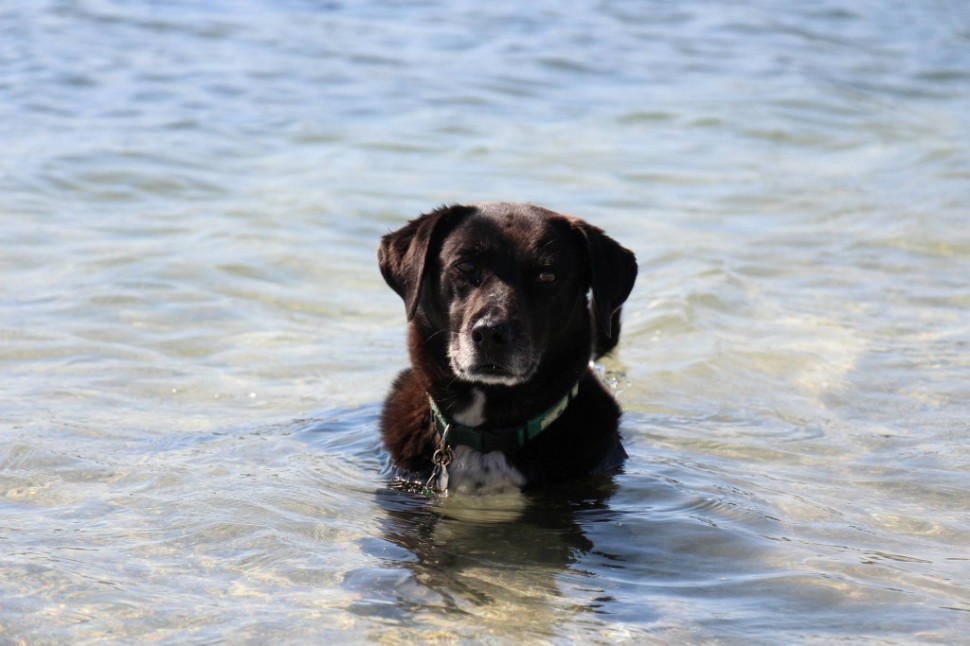Neko got mistaken for a puppy yesterday. Can’t imagine why 😉
Neko is 10! On loving my older dog
Neko turns 10 this week. Or, you know, sometime this month. You know how it is with rescue dog birthdays. It’s exciting because it’s quite a landmark for any dog, but it’s that much more exciting because, when Neko received her bone tumor diagnosis, I thought we’d never reach this point.
If you haven’t read Neko’s bio, she lost a leg to osteosarc a few months before her sixth birthday. She was given a 12-18 month prognosis from there even with treatment. Going ahead with treatment, I still pre-emptively mourned the lazy old mutt I would probably never get to bum around with. I worried that I would lose her before I was in a living situation that would allow me to adopt another dog, especially after my landlord turned down my request to bring another dog in after I’d met someone who was looking to find a new, loving home for their dog for a variety of reasons. I’d always imagined being able to get another dog while Neko was still around so that she could show them what’s what. I suppose it’s not totally out of the realm of possibility yet, but aside from the fact that my landlord won’t allow another dog, I don’t have room in my life to give a puppy or young dog the time and attention they really need right now.
I remember the frenetic energy Neko had when she was a pup – really up until her brains got delivered at some point when she was 2. We would spend hours romping around in the woods trying to burn off the energy, and I suspect Neko covered something like four times as much distance as I did with all her zigging and zagging, her running ahead and running back. I lost 70 pounds in the first two years I had Neko (only about 50 of which I could really stand to lose), due to the combination of the forest-romping and the underemployment that gave me the time to do it. I don’t have that kind of time these days, and a dog that age really needs that level of activity to keep their brain happy.
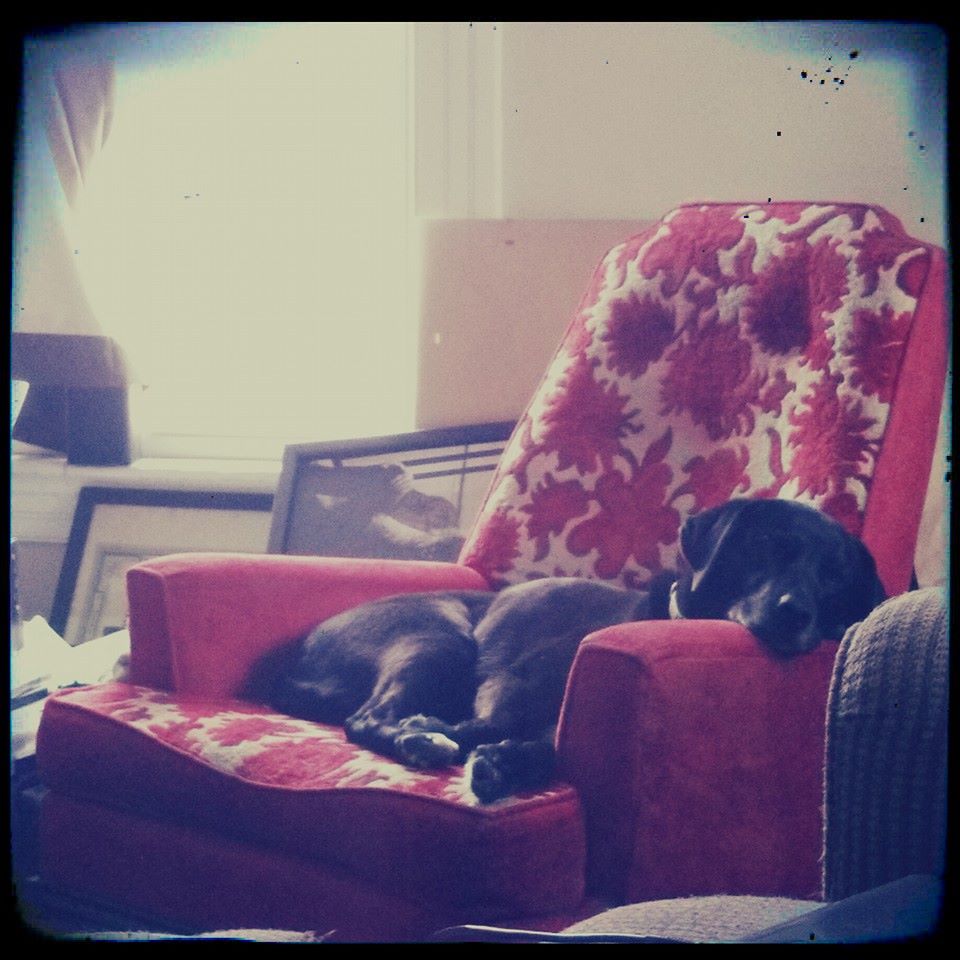
Neko still gets into moods where she wants to sprint circles around me – the other day she orbited me at top speed for several minutes and the flash of crazy puppy-ness was like a magical time machine. She still greets me with the same song and dance routine she always has when I get home from work. But she’s also pretty happy to spend most of the day sprawled on the guest bed, looking out the window, or curled up in her favorite chair, which I’m not entirely sure how she fits into. I am loving the chill older dog energy.
The fact that I thought I’d never get to see them makes me treasure the gray in her muzzle and the old dog lump on her belly (and yes, it’s just a benign lipoma). Everyone get a little creaky as they get older, regardless of their leg count. It’s something to keep in mind with our tripawds, especially if they lost their leg as a young dog, when we are inclined to suspect every creak. It also makes hearing stories of people surrendering their 9 year-old dogs in favor of a younger one go from merely disgusting to a personal slap in the face to each of us that have struggled just to get to that point with our dogs (whether we’ve made it or not).
I don’t have illusions about the challenges that life with an older dog may bring: Gentle, the lab-setter mix my parents got 10 months before they got me, lived well past her 15th birthday, though she didn’t quite make it to 16. There were points that got really rough in the last few years. But one thing about the way dogs perceive time – the way they only seem to see things in terms of now or forever – means that elderly dogs don’t have the same regrets of a lost past or fears about the future that we do as humans (photographer Nancy LeVine’s series Senior Dogs Across America is built around this idea and seriously worth checking out). This perception of time also offers us as Tripawd companions a useful lesson about the serenity of focusing on, living in and enjoying the present moment – warm sun and a gentle breeze on soft fur while sprawled on new grass, a playful, hungry, bouncing “welcome home” song and dance, feet in a cool stream on a hot day – rather than building anxiety about six months or a year down the road. We’re already doing everything we can. Loving the moment is part of that.
Happy Birthday, Honey Bear. Whatever it is you’re doing, keep it up.
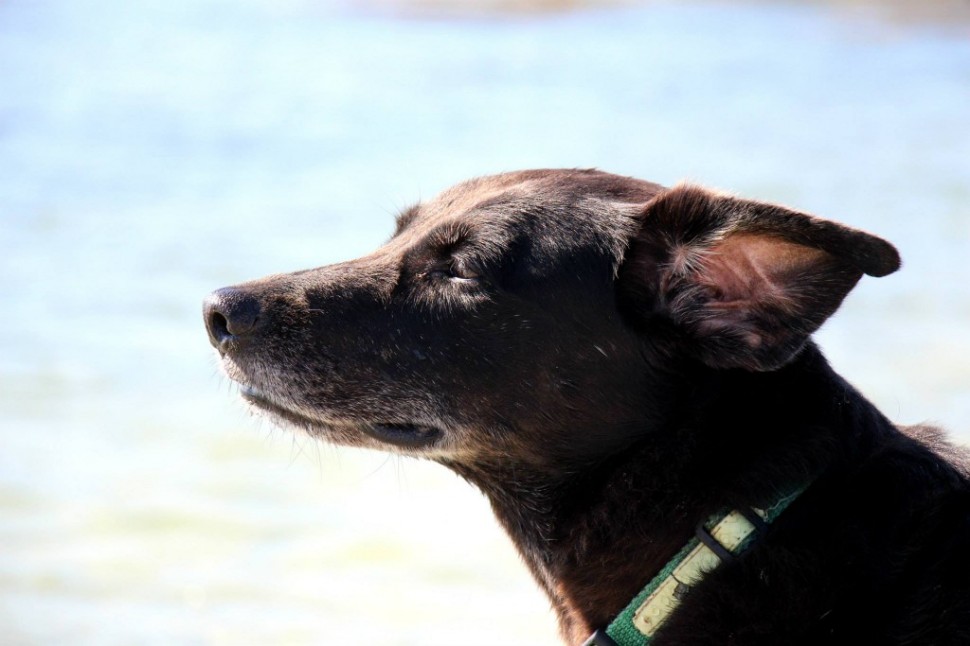 photo: Alejandro Coakley
photo: Alejandro Coakley
Tripawds Get Sick, Too. They Also Get Better.

On Neko’s third ampuversary, I posted a picture of her happily emerging from a giant snowbank to the Tripawds facebook wall. One of the replies I got was from a woman who was very concerned about her tripawd, who had some very scary symptoms going on. She wanted to know if Neko had ever had any symptoms like her dog was having in her time as a tripawd.
Dogs get sick. It’s just a fact. Tripawds are no exception. But for those of us whose dogs lost their leg to cancer, any kind of sickness, any situation with your dog being not quite themselves, can easily jar us back into the cancer state of mind and make us assume the worst. It’s terrifying. I’ve been making myself anxious even thinking about it enough to write this. But dogs usually get better. Tripawds are no exception here, either.
If you don’t want to read details about my dog being seriously ill (but then recovering fully!) I don’t blame you, but you might not want to keep reading.
Neko’s had two really serious illnesses in her time as a tripawd. The first was very close to her second ampuversary. I came home from work one day to find her out in the yard, which was not unusual. My sister, whom I lived with at the time, often let Neko out when she got home from work, a few hours before I got home. But never had Neko not bounced up to greet me when she was out when I got home. Instead, she remained lying by the big flowerpot at the bottom of the stairs. As I walked up she took great pains to stand up and take a few hobbled steps towards me. As I went up the stairs to the door, it became clear that she couldn’t make it up on her own, which had never been a problem, not even the day she came home from her amputation. It was doubly puzzling because she had seemed fine that morning before I left. I carried her up and plopped her in her spot on the couch. She was shivering, which is usually the only way I can tell she’s really in pain. It reminded me so vividly of when she had been sick before her leg came off, though more acute in many ways. She started to move some later, though still with great effort. She ate, though I had to bring her bowl to her on the couch. The next morning, she seemed a little more alert, but still wasn’t moving well. I brought her outside to take care of business but she just lay down on the frozen grass and sniffed the air. I lay next to her on the ground while I waited for a call back from the vet on call that Sunday. Illustrating why I’ve stayed with this vet’s office despite the hour’s drive from where I live now, the vet said she’d meet me in at the office in an hour and a half. I called my parents, who live closer to the vet and asked them to meet me there. I was more than halfway convinced that I was going to get fatally bad news there or that it could even be Neko’s last ride right then, and didn’t want to get that news alone like I did two years earlier, when I was blindsided with the suggestion that her limp could be due to cancer.
I suspect Neko is not alone in her preternatural understanding of when she’s going to the vet. On the way there, Neko demanded to go out for the first time since I had carried her up the stairs. We stopped at a rest area and she not only hopped around almost like nothing was wrong, but took care of business with stunning speed and professionalism. By the time we got to the vet I was a little less worried. My parents and the vet were there when I arrived. The vet had brought her daughter and my father was reading books with the vet’s daughter on his phone. Neko, of course, was in denial about her symptoms from the last day. “I’m fine,” she wagged and smiled at the vet, “Can I not be at the vet anymore?” As reassuring as it was to see her looking more alive, I left with the same report I had the first time I brought her in with a limp: It could be related to Lyme or an injury (which both Neko and I have had to deal with in the past), let’s give her an antibiotic and some painkillers and see if it clears up.
And guess what? This time, it did. Neko was totally back to being herself days later.
The second time she got sick was scarier in some ways, though less specifically triggering. It was less like when she got sick leading up to her amputation, but was in other ways more acute. She woke me up in the middle of the night to go out, which she rarely does, and then had severe diarrhea. Initially, I didn’t think much of this, as this is not always cause for severe alarm. Often, a 12-24 hour fast followed by bland food clears it up. Neko was disappointed when I wouldn’t give her breakfast in the morning and dejectedly licked the bottom of her empty water bowl. That evening, I gave her a little dilute chicken broth. It came back up about an hour and a half later. I called the vet to see what she thought. The vet said that if she started vomiting or pooping blood to take her into the emergency vet, but that otherwise she’d see us in the morning. Neko continued to retch periodically throughout the night, producing little, but no blood. I couldn’t sleep, listening for her, and so I decided if no one was going to sleep on this, I might as well just take her to the emergency vet, deal with it, and avoid having to arrange coverage for the first few hours of the day at work. The emergency vet gave her a diagnosis of hemorrhaging gastroenteritis, kind of a catch-all term for severe inflammation of the GI tract, and admitted her for observation and treatment. There were some even scarier bits in there involving bloody diarrhea, but I will spare the details there. I’m just glad that happened when we were already at the vet. The thing about hemorrhaging gastroenteritis is that as horrifying as it is, it’s typically entirely treatable. Neko had to stay overnight to get some IV fluids and get a jump on treatment, but turned around very fast.
These are horror stories with happy endings. As scary as these situations were for a few days, neither was the big C back to claim Neko for good. Instead, Neko is curled up next to me on the couch, wondering when we’re finally going for a walk so she can run around, bury her face in snow and smell everything at least twice, or if we’re going to visit my friend’s new baby, whom she’s fallen in love with. Or maybe she’s just wondering if it’s time for dinner yet. We, as tripawd companions, are painfully aware of the statistics about cancer coming back. Many of us have made our peace with the idea of living with our friends on blessed and borrowed time. But just like any other dog, tripawds sometimes just get sick. It’s scary and it sucks, but they usually get better.
Onyx and the Orchard
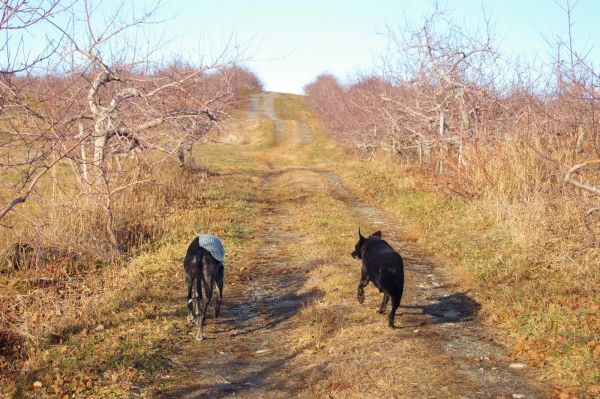
Neko got to have the rare treat of getting to romp outside and off leash with her greyhound pal, Onyx, this week. Onyx is my mom and stepmom’s dog, a retired racing greyhound that is, interestingly enough, only a few months younger than Neko. In part of the contract that they signed when they adopted Onyx, they agreed to never let her off leash in an unenclosed area. From what I understand, it’s a pretty standard condition for rescue greyhounds, and not an unreasonable one: if the dog gets spooked and takes off, they can do so at up to 45 mph. And, as calm and loving as they open up to be, rescue greyhounds have more tics than the average pooch. But I’ll get to ceiling fans later. The orchard, a short walk from my mom’s up the steep, winding Poop Hill Road, is an enclosed space acres and acres across, and makes an ideal place for Onyx to be able to romp and play.
Onyx came on the scene about six months after Neko lost her leg. When she first came home, she was still fairly nervous, withdrawn and in need of a lot of emotional support. So much so, in fact, that she wasn’t going to stand for sleeping in a room by herself. This was further complicated by the fact that she hadn’t quite figured out stairs yet. They don’t really come up for racing dogs. She had gotten some lessons and guided practice at Fast Friends, the rescue outfit where my mom adopted her, but she wasn’t confident enough to walk up the two small flights at the house. So, my mom was sleeping downstairs on the couch, with the dog. This was not a sustainable plan.
My mom called to ask if Neko could come over to give Onyx some stair climbing lessons. She’d heard that one of the best strategies for getting over this particular hurdle was to have it modeled by another dog, and Neko didn’t miss a beat climbing stairs after her amputation. So, Neko and I came over. I ran up and down the stairs with Neko a few times and Onyx watched. We stood at the top of the stairs and called both dogs with treats. Eventually, Onyx went up the stairs and back down and, for the first night since Onyx had arrived, nobody had to sleep on the couch.
Onyx has opened up so much more since then, even if she still has an intense distrust of all ceiling fans, whether or not they’re on (which is a problem when she comes over, since of the five rooms in my apartment, only two – a bedroom and the bathroom – lack ceiling fans), but the orchard was a huge breakthrough. Out of her harness and leash, Onyx started making play invitations and bouncing in a crazyfooted way. It’s always a treat to see Neko and Onyx, the tripawd and the rescue grey, romping and playing together, stopping to sniff the trees, downed apples and possible bear poop, and, generally, demonstrating what it means to be dog.
Phantom Leg Activity: Things That Shouldn’t Work, but Do
When little kids ask why my dog has three legs, I often reply, “Shh! Don’t tell her, she doesn’t know!”
Sometimes, I have a sneaking suspicion that it might be true, though, even after three years on three legs. Even though Neko didn’t miss a beat after her amputation, hopping right up the stairs to our second floor apartment immediately after returning from her surgery, she has a few habits that simply shouldn’t work with a leg missing. And yet…
Neko has always had an odd, occasional habit when squatting to pee: she would squat, then pick up one of her hind legs, so that she was balanced on three legs. I used to call it the “yoga squat” (you can learn a lot about yoga from a dog – I don’t know that you can do Downward Dog properly until you’ve seen it done by an actual dog). She didn’t do it every time she had a pee, but with fair regularity. I would say that this was an oddly prescient way of practicing for her future life on three legs except that the leg she used to pick up, invariably, is the hind leg she got to keep.
Shortly after her amputation, I witnessed her pull this move again, picking up that same leg after squatting, leaving her balanced totally on her two front legs. And it worked, possibly because it didn’t occur to her that it wouldn’t. It looks like an interesting variation on Crow pose, a yoga pose which involves balancing your whole, crouched body on your arms. I can’t say Neko pulls this move as frequently as she used to, but it’s a surprise every time.
She still scratches with her missing leg as well. The stump starts drawing tiny, purposeful circles in the air; Neko leans her head out to the side for a better scratching angle behind the ear, making the tightened up scratching face. I have no way of knowing if she gets a certain amount of satisfaction just going through the process or if she does it because it still, in a roundabout way, works. Whenever I see her pull that, I give her a scratch where she’s aiming. The leg keeps going even when it’s me doing the scratching.
Perhaps the presence or absence of the leg is simply immaterial. She’s never really seemed puzzled by its absence, but still has habits that include the fourth leg in her residual self-image. She definitely dreams with four legs; the stump twitches purposefully with all the other legs when she runs in her sleep. I imagine a dog’s number system as comprising only yes and no (for advanced situations, it may also include more). It covers most of their purposes. This doesn’t leave a whole lot of room to be concerned with the difference between 3 and 4, and really just comes down to what works and what doesn’t. Sometimes, what works is improbable and surprising, and takes someone who doesn’t suspect it won’t to prove otherwise.

